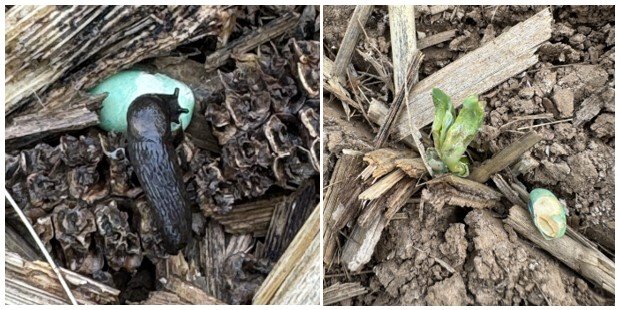Slugs and Snails Affecting Pre- and Post-Emergent Soybeans
By Raul T. Villanueva, Entomology Extension Specialist, and Zenaida Viloria, Entomology Research Analyst University of Kentucky’s Research and Education Center at Princeton, KY.
Abundance of Slugs and Snails in 2014
The warmer winter season in 2024, rains and foggy conditions during several days in March and April, have been conducive for the presence of slugs and snails in commercial and research plots in Western Kentucky. Since the end of March and the first week of April we have been observing slugs in various stages of development as well eggs in soybean and corn fields. The favorable conditions described above might have increased their populations in field leading to a reduction of plant stands in several soybean fields, and in many cases entire fields were consumed. In fields heavily affected by slugs, plant stands per 5-ft row reached from 2 to 10 while these numbers under normal conditions should be between 20 to 30 plants per 5-ft row (average planting in KY: 5 to 6 seeds per ft-row in soybeans planted in 20” row width) (Figure 1). Snails were also observed in abundant number in fields that have irrigation and abundant organic matter (Figure 2). Feeding behavior captured in fields showed that slug were feeding in insecticide and fungicide treated unsprouted seeds, and emerging seedlings (Figure 3). Either insecticides or fungicides do not affect slugs or snails. Also, observations since the first week of April have shown that eggs were laid in moist soils covered by organic matter from previous crop (soybeans, corn, or wheat). Figure 4 shows that slugs and snails were well protected under the dry brace roots of corn and ovipositing eggs under these structures.
Figure 1. Images of 5-ft row in two soybean fields showing the reduction of plant stands caused by slug feeding: 4 plants (left picture) and 10 plants (right picture) (yellow arrows) in the center rows. Under normal conditions there should be 20 to 30 plants per 5-ft row lengths.
Figure 2. Soybean seedlings and dead slugs collected per 5-foot rows. Notice the different sizes of snails collected after the application of the metaldehyde baits.
Figure 3. (Left) Slug feeding on pesticide coated, swollen, and unsprouted soybean seed. (Right) Feeding damage on emerged and unsprouted seed.
Figure 4. Corn stalk left in the field with the brace roots that sheltered snails and their eggs. Although, 2 eggs are shown in this image more than 15 snail eggs were found under the brace roots (Photo by R. T. Villanueva)
Mollusk Management
There is no rescue treatment for slug damage or thresholds for application of molluscicides. If stands are low replanting is recommended and an application of molluscicides may be necessary. In February 27, 2024, we wrote an article titled “Slugs are Active in February 2024, but Farmers Have Two Registered Molluscicides under Section 24(c) in Kentucky”. In this article we wrote about the possibility of the abundance of mollusks during the germination period of corn or soybeans based on the environmental conditions and on two metaldehyde molluscicides that are registered under the Section 24(c) for soybeans and corn in Kentucky: Deadline® M-Ps™ and Slug-Fest®. In addition to these two products, Table 1 shows additional molluscicides that can be used in corn and soybeans for management of slugs or snails. Please read the molluscicide labels for the correct use of these products.
Table 1. Molluscicides* that are available in Kentucky for the management of slugs and snail in corn and soybeans.
*The University of Kentucky does not endorse any of the products listed here, they are shown here for information purposes only.





